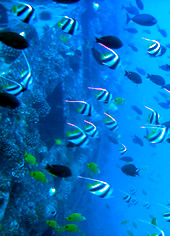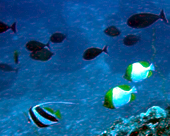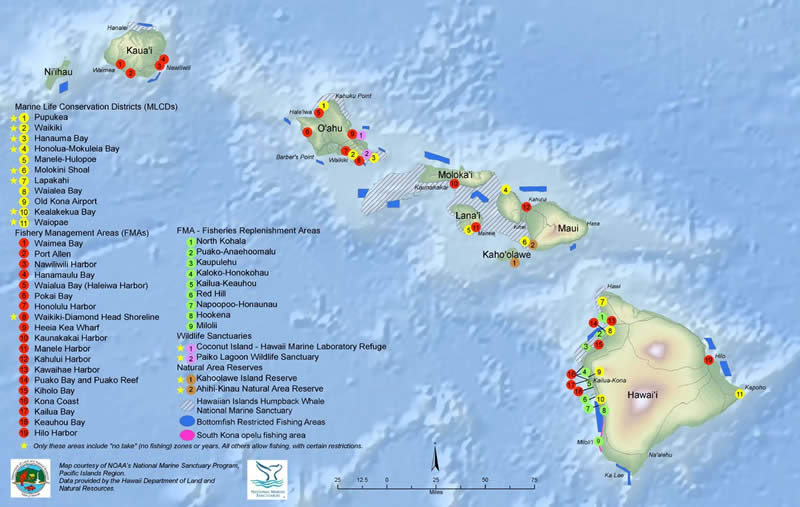Corals
In 2008 Hawaii legislature introduced a bill and passed a new law to increase fines for coral damage. This law was based on an incident where a tourist boat sank and destroyed a large area of coral in a Marine Preserve. This law is intended to deter future damage to Marine Preserves, National Monuments and state wide coral reefs with huge fines to go to the state to help repair or prevent damage. The following is some information about corals.
Corals grow 3 to 5 inches a year. Soft corals in shallow water grow the quickest. Deep corals like black and gold corals grow very slowly. The perfect coral growth study was done using new lava fields off the Big Island. Lava flows under water 25 years old had a decent amount of coral growth covering a much of the new lands surface. One hundred year old lava had nearly complete reef coverage. The coral growth on the lava flows consisted of mostly slower growing hard corals (“Hawaii Coral Reef Ecology” by David Gulko, 1998).
Hawaiian reefs can re-grow and cover large areas in a very quick amount of time. This is important as many fish use coral for breeding and safety. With in a few years the sunken ship at 100 feet deep of Waikiki the YO57 had many hard coral growth areas with in a few years. When large ships run aground in Kaneohe Bay coral re growth is very quick. Deeper corals are more at risk as they are slower growing as coral growth rates are dependant on the amount of light corals receive. The Molokini incident where a large area of deeper corals was damaged will be with us for some time. Other deep coral damage occurs when large ships anchors drag 10 foot wide strips clearing smaller coral when their anchors drag outside Honolulu Harbor, Barbers Point and other large ship anchorages’.
Numerous permits for dredging have been issued over the years. Huge coral areas were dredged by the State of Hawaii in the creation of Barbers Point Harbor. 100 million cubic tons of coral were dredged in the 1940’s from Kaneohe Bay for war time reasons. Much of the Kaneohe Bay 10 foot deep dredging is now only 3 to 4 feet deep. Private channel dredging permits are given for many house private docs like those in Kaneohe Bay.
What about permits to remove small amounts of natural corals for certain projects? When small pieces of coral are broken it stimulates and increases coral growth rates. Waikiki Aquarium grows and sells Acropora Coral which grows 7 inches a year by breaking pieces off for sale and then it regrows quickly.
Sustainable coral and aquiculture projects can be done with no impact to the environment and provide much needed jobs for a declining tourism based economy.
Maui harbor is to be dredged soon because the coral growth is posing a risk to ships going into the harbor. Pearl Harbor just completed another huge dredging project to maintain the Pearl Harbor Channel. CRAMP is also looking into large coral transplants from Hawaii’s harbors. Huge 60 foot patches of shallow soft corals that have grown over sandy areas of Kaneohe Bay in the past three years.
What about demolition of cement buildings used in some desolate areas as reef foundations? This would be a very beneficial use of cement garbage. Corals grow quick on ceramic and other substrates as they promote colony attachment.
Thank You
Give Thanks and Support
We wish to thank the DNLR and the state legislature for all the legislation in the past that has led to increase fish counts, monk seal counts up from one in the 80’s to 30 on Oahu today.
Please continue to support artificial reefs they create condos for all the fish and greatly increase populations of all fish; They are nearly impossible for fishermen especially tropical fish divers to collect fish in so they are great for the fish!!


